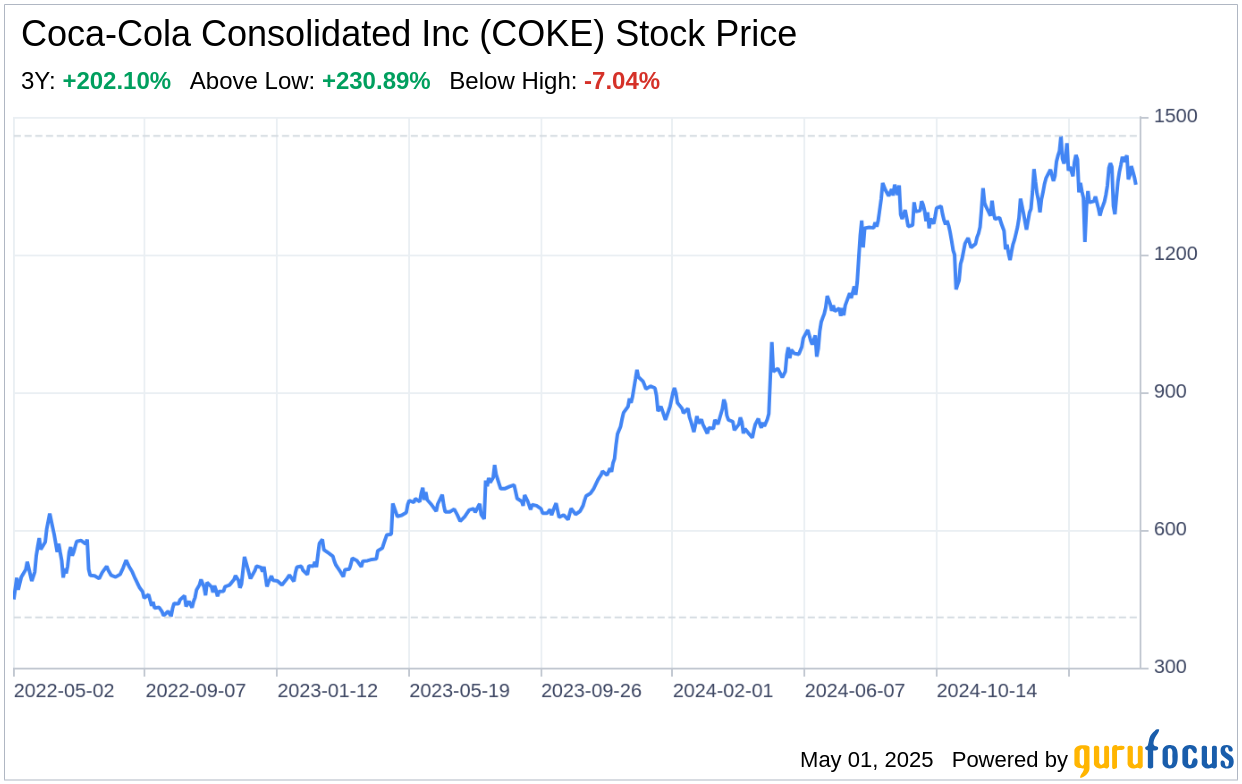On April 30, 2025, Coca-Cola Consolidated Inc (COKE, Financial), a leading distributor, marketer, and manufacturer of nonalcoholic beverages, filed its 10-Q report with the SEC. This SWOT analysis delves into the company's financials and strategic positioning, providing investors with a nuanced understanding of COKE's operational and market dynamics. The first quarter of 2025 saw a slight dip in net sales to $1.58 billion compared to $1.59 billion in 2024, with net income also decreasing from $165.74 million to $103.61 million. Despite these challenges, COKE maintains a robust brand and a diverse product portfolio in the nonalcoholic beverage sector.

Strengths
Brand Power and Market Presence: Coca-Cola Consolidated Inc's foremost strength lies in its powerful brand and expansive market presence. As the largest Coca-Cola bottler in the United States, COKE benefits from high brand recognition and consumer loyalty. The company's association with Coca-Cola, one of the world's most iconic brands, provides a competitive edge in the marketplace. Moreover, COKE's extensive distribution network, spanning 14 states and the District of Columbia, ensures a pervasive reach and a strong foothold in the nonalcoholic beverage industry.
Product Diversification: COKE's product range extends beyond its principal sparkling beverage, Coca-Cola, to include still beverages such as bottled water, ready-to-drink tea, coffee, energy drinks, and sports drinks. This diversification allows COKE to cater to a wide array of consumer preferences and adapt to shifting market trends. The company's ability to innovate and introduce new products reinforces its market position and mitigates risks associated with reliance on a single product line.
Operational Efficiency: The company's investment in a new 430,000-square foot automated distribution center in Columbus, Ohio, exemplifies its commitment to operational efficiency. By optimizing distribution and leveraging technology, COKE aims to enhance productivity and customer service, which are critical components of its long-term growth strategy.
Weaknesses
Volume Decline and Sales Challenges: The first quarter of 2025 witnessed a 6.6% decline in volume, with a notable decrease in net sales. Factors such as fewer selling days and the timing of the Easter holiday contributed to this downturn. Additionally, the shift in distribution of casepack Dasani water to a non-DSD method impacted reported case sales volume, reflecting a need for COKE to adapt its sales strategies to evolving market conditions.
Financial Performance Pressure: The decrease in net income from $165.74 million in 2024 to $103.61 million in 2025 raises concerns about COKE's financial resilience. This decline may affect investor confidence and the company's ability to invest in growth initiatives. Furthermore, the reduction in basic and diluted net income per share indicates potential pressure on shareholder returns.
Commodity Price Volatility: COKE's exposure to commodity price fluctuations, particularly for raw materials like aluminum and PET resin, presents a financial risk. While the company employs hedging strategies to mitigate this risk, the inherent volatility of commodity markets remains a challenge that can impact cost of sales and overall profitability.
Opportunities
Market Expansion: COKE has the opportunity to expand its market reach by entering new territories and exploring untapped consumer segments. The company's strong distribution capabilities and brand partnerships position it well to capitalize on growth opportunities in both domestic and potentially international markets.
Product Innovation: Consumer trends toward healthier and more sustainable beverage options present an opportunity for COKE to innovate and diversify its product portfolio further. By focusing on the development of low-sugar, organic, and eco-friendly products, COKE can attract health-conscious consumers and drive sales growth.
Digital Transformation: The investment in a digitally enabled selling platform, MyCoke, highlights COKE's opportunity to leverage technology to improve customer engagement and operational efficiency. The platform's potential to create a more seamless order and payment process can enhance customer satisfaction and open new sales channels.
Threats
Intense Competition: The nonalcoholic beverage industry is highly competitive, with COKE facing stiff competition from local bottlers of PepsiCo, Inc. products and other regional players. The company must continuously innovate and maintain competitive pricing to retain market share and consumer preference.
Regulatory Changes: Changes in regulations related to health, safety, and environmental standards can impose additional costs and operational challenges for COKE. The company must navigate these regulatory landscapes effectively to avoid potential fines, legal issues, and reputational damage.
Economic Fluctuations: Economic downturns and shifts in consumer spending patterns can adversely affect COKE's sales volume and profitability. The company must remain agile and responsive to economic indicators to manage risks associated with consumer demand and purchasing power.
In conclusion, Coca-Cola Consolidated Inc (COKE, Financial) exhibits a strong brand presence and product diversification, which are pivotal to its market success. However, the company faces challenges in sales volume and financial performance that require strategic attention. Opportunities for market expansion, product innovation, and digital transformation offer pathways for growth, while competition, regulatory changes, and economic fluctuations pose significant threats. COKE's forward-looking strategies, including operational efficiency and digital enablement, are crucial for leveraging its strengths and opportunities to mitigate weaknesses and threats.
This article, generated by GuruFocus, is designed to provide general insights and is not tailored financial advice. Our commentary is rooted in historical data and analyst projections, utilizing an impartial methodology, and is not intended to serve as specific investment guidance. It does not formulate a recommendation to purchase or divest any stock and does not consider individual investment objectives or financial circumstances. Our objective is to deliver long-term, fundamental data-driven analysis. Be aware that our analysis might not incorporate the most recent, price-sensitive company announcements or qualitative information. GuruFocus holds no position in the stocks mentioned herein.
